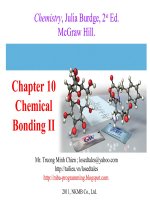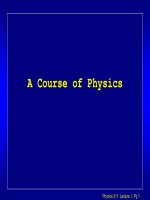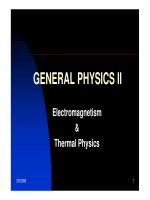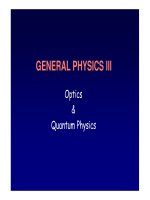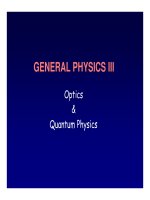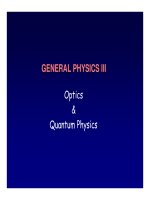Tài liệu Chapter 10: Rotation docx
Bạn đang xem bản rút gọn của tài liệu. Xem và tải ngay bản đầy đủ của tài liệu tại đây (327.72 KB, 18 trang )
Chapter 10
Rotation
In this chapter we will study the rotational motion of rigid bodies about
a fixed axis. To describe this type of motion we will introduce the
following new concepts:
-Angular displacement
-Average and instantaneous angular velocity (symbol: ω )
-Average and instantaneous angular acceleration (symbol:
α ) -Rotational inertia also known as moment of inertia (symbol
I ) -Torque (symbol τ )
We will also calculate the kinetic energy associated with rotation, write
Newton’s second law for rotational motion, and introduce the work-
kinetic energy for rotational motion
(10-1)
The Rotational Variables
In this chapter we will study the rotational motion of rigid
bodies about fixed axes. A rigid body is defined as one that
can rotate with all its parts locked together and without any
change of its shape. A fixed axis means that the object
rotates about an axis that does not move. We can describe
the motion of a rigid body rotating about a fixed axis by
specifying just one parameter. Consider the rigid body of
the figure.
We take the the z-axis to be the fixed axis of rotation. We define a reference line
which is fixed in the rigid body and is perpendicular to the rotational axis. A top
view is shown in the lower picture. The angular position of the reference line at
any time t is defined by the angle θ(t) that the reference lines makes with the
position at t = 0. The angle θ(t) also defines the position of all the points on the
rigid body because all the points are locked as they rotate. The angle θ is related
to the arc length s traveled by a point at a distance r from the axis via
the equation: Note: The angle θ is measured in radians
s
r
θ
=
(10-2)
1
2 1 2
2 1
In the picture we show the reference line at a time and
at a later time . Between and the body undergoes
an angular displacement
An
.
gular Displace
All the points of th
ment
e
rigid
t
t t t
θ θ θ
∆ = −
body have the same angular displacement because they
rotate locked together.
( )
1
2 1
2 1
2
We define as average angular velocity for the time interval , the ratio:
We define as the instantaneous ang
The SI unit for angular velocity is
An
rad
gular Velocity
ians/second
avg
t t t
t t
θ θ θ
ω
− ∆
= =
− ∆
0
ular velocity the limit of as 0
lim This is the definition of the first deriva
Algerbraic sign of angular f
tive with
If a rigid body rotre atquen es cy: counterclockwise
(CC
W
t
t
t
t
t
θ
θ
ω
∆ →
∆
∆ →
∆
∆
=
∆
) has a positive sign. If on the other hand the rotation is clockwise (CW)
has a negative sign
ω
ω
(10-3)
t
1
t
2
d
dt
θ
ω
=
If the angular velocity of a rotating rigid object changes
with time we can describe the time rate of change of
by defining the
Angula
angula
r Accelerati
r acelera
on
tion
ω
1 2
1 1 2 2
In the figure we show the reference line at a time and at a later time .
The angular velocity of the rotating body is equal to at and at .
We define as average angular acceleration fo
t t
t t
ω ω
( )
1 2
0
2 1
2
2
1
The SI unit for angular velocity is radia
r the time interval , the ratio:
We define as the instantaneous angular acceleration the limit of
ns/sec
as
lim
ond
0
av
t
g
t t
t
t t
t
t
ω ω ω
ω
α
ω
α
∆ →
∆
∆ →
− ∆
=
∆
∆
=
−
∆
=
This is the definition of the first derivative with t
t∆
(10-4)
ω
1
ω
2
t
1
t
2
d
dt
ω
α
=
For rotations of rigid bodies about a fixed axis
we can describe accurately the angular velocity
by asigning an algebraic sigh. Positive for
counterclockwi
Angul
se ro
ar Velocity Ve
tation and ne
ctor
gative for
clockwise rotation
We can actually use the vector notation to describe rotational motion which
is more complicated. The angular velocity vector is defined as follows:
The of is along the rotationdirecti axis.
h
n
T
o
ω
r
e of is defined by the right hand rule (RHL)
Curl the right hand so that the fingers point in the direction
of the rotation. The thumb of the right
sense
R
hand gi
ight hand rule
ves the sense
:
f
o
ω
r
r
ω
(10-5)
When the angular acceleration is constant we can derive simple e
Rotation with Constant Angular Accelerati
xpressions
that give us the angular velocity and the angular p
on
osit
α
ω
ion as function of time
We could derive these equations in the same way we did in chapter 2. Instead we
will simply write the solutions by exploiting the analogy between translational
and rotational m
θ
Rotatio
otion u
nal Mot
sing the follo
ion
wing correspondance between
Tran
the two motions
slational Motion
x
v
θ
↔
↔
( ) ( )
0
2
0
2
2 2 22
(eqs.1)
(eqs.2)
2
(
2
2 2
o o
o oo o
o
a
v v at
at
x x v t
v v x
t
t
a x
t
ω
α
ω ω α
α
θ θ ω
ω ω α θ θ
= +
= + +
− = −
= +
↔
↔
↔ = +
− = −↔
+
eqs.3)
(10-6)
Consider a point P on a rigid body rotating about
a fixed axis. At 0 the reference line which connects
the origin
Relating the Linear and A
O with point P is on the
ngular Var
x-axis (po
iable
int
s
A)
D
t =
»
uring the time interval point P moves along arc AP
and covers a distance . At the same time the reference
line OP rotates by an angle .
t
s
θ
A
θ
s
O
( )
The arc length s and the angle are connected by the equation:
where is the dista
Relation b
nce OP. T
etween angular velocity a
he speed of point P
nd speed
d r
ds d
r v r
dt dt dt
s r
θ
θ
θ
θ
= = ==
v r
ω
=
circumference 2 2 2
The period of revolution is given by:
speed
r r
T T
v r
π π π
ω ω
= = = =
2
T
π
ω
=
(10-7)
1
T
f
=
2 f
ω π
=
